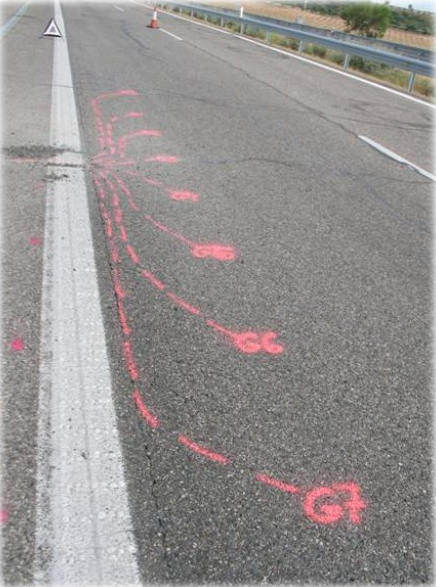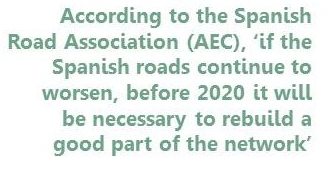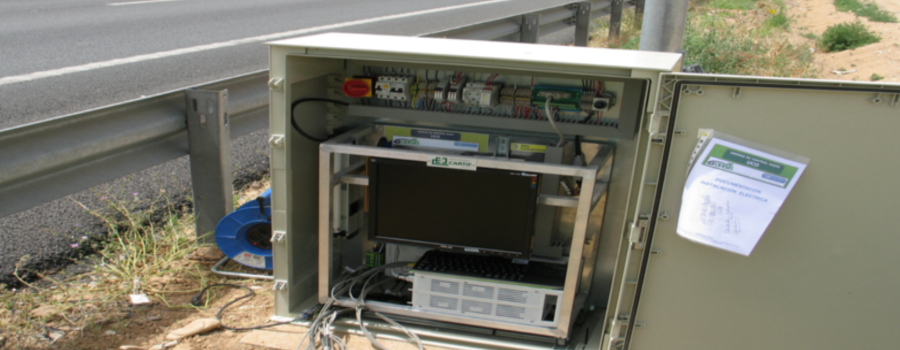To a large extent, when driving on the road, our safety depends on the state of the pavement. Real-time information provided by embedded sensors can help us to take action before deterioration (risk) occurs. What can we do to power these autonomous sensors? Piezoelectric devices vs. wireless power transmission?
The fundamental objective of road pavement is to provide users with a quality service that meets their mobility needs during the lifetime for which it is designed. A situation of deterioration generates a greater risk of an accident, more driving discomfort, fuel consumption, vehicle deterioration, harmful emissions to the atmosphere…
In May 2016, the Spanish Road Association (AEC) published the report “Study on Conservation Investment Needs” to review the state of the Spanish road network. The report notes that the state of maintenance of roads continues to worsen. If this trend continues, before 2020 it will be necessary to rebuild a good part of the network.
I agree with the experts that the conservation of our roads cannot be left to chance: nor to depend on crisis situations that force the budget to be reduced or to wait for irreversible situations.
In these circumstances, it is necessary to continue developing new technologies and methodologies that support the management of infrastructures and that allow conserving and rehabilitating our road network at the lowest economic and environmental cost.
Instrumentation with sensors embedded in the pavement
Traffic and environment/weather conditions, aggravated by climate change problems, significantly affect the pave roads deterioration.

The number of axles, the load per axis, the vehicles speed…, affect the structural behavior of the pavement. Solar radiation, rainfall, thermal gradients, ice-melt cycles, melting salts used against ice or the spillage of oils and fuels, among other factors, have a significant impact on pavement life and fatigue.
Preventive maintenance is necessary based on information on the state of the pavement and aimed to prevent the occurrence of this deterioration or to correct it quickly through repair and maintenance.
Visual inspection and periodic auscultation are commonly used to assess the condition of a pavement. A dynamic alternative is the instrumentation with sensors embedded in the pavement. With continuous monitoring it is intended that those who make decisions can know, in real time, the status of the pavement.
Experiences such as those of the CENIT OASIS project, in which we collaborate with OHL Concesiones and GEOCISA, endorse this alternative, not without difficulties such as that the sensors overcome the aggressive conditions during the spread and the compaction, or feed the sensors along the lifetime of an asphalt pavement that is normally between 20 and 30 years.
In this second aspect, since wired power is not always available or to overcome the problems of wiring flexibility, a significant technological challenge is to embed autonomous sensors in the pavement with non-wired power supply and wireless communication. How to provide energy to the sensors without cables and during the lifetime of the pavement?
Piezoelectric devices vs. wireless power transmission?
Opposite to batteries power supply, which have a limited energy, requires a periodic replacement or recharge, the sensors can be powered with energy captured from the road itself, for example by means of piezoelectric devices.

At the end of the 19th century, Pierre and his brother Jacques Curie discover the piezoelectric effect, a phenomenon that occurs in certain crystals that when subjected to pressure or mechanical movement, electrical energy is generated. On the road, part of the vehicle’s energy is converted into vertical deformation of the pavement that can be transformed into electrical energy by piezoelectric devices. The amount of energy generated depends on the number of vehicles passing.
In the CIEN REPARA 2.0 project we have choosed another method, investigating, in collaboration with Sacyr Construcción, Acciona Infraestructuras, Repsol, Fractalia, CHM, Censo, Solid Forest and Inzamac, the recharge of the autonomous sensors batteries by mean of wireless power transmission.
Also at the end of the 19th century, Nikola Tesla proposed what is known as “Tesla effect”, variations in magnetic flux have the ability to transmit electricity at a distance without needing solid support or some kind of wire. On the road, the batteries of the sensors will be recharged periodically, according to their power needs (mainly defined by the data transmission). Energy transfer has a limited range.
Actually, the efficiency of both technologies is a critical point.
Curie vs. Tesla? Indeed, confronting these technologies (using “versus” with the meaning of “against”) is not a lucky expression. Both technologies open up a world of opportunities for new applications. Are they also complementary? Which is your opinion?
- Digitizing the construction to prepare the future - 4 May 2017
- Curie vs Tesla? Autonomous sensors embedded in the pavement - 31 January 2017
- Safety in collaborative robotics - 27 June 2016
